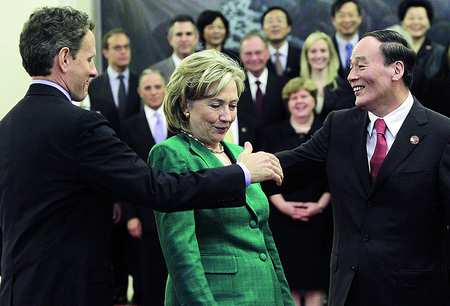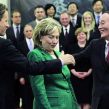
U.S.-China Strategic & Economic Dialogue: Not Exactly a “Dialogue”
Publication: China Brief Volume: 10 Issue: 12
By:

More than 200 American officials converged on Beijing in late May for the second U.S.-China Strategic and Economic Dialogue. After two days of intensive discussions with their Chinese counterparts, the American side boasted of many accomplishments. The State Department, working on the "strategic" track of the Dialogue, pointed to "26 specific outcomes,"[1] which included, "talked broadly about development issues, and agreed to enhance communication and dialogue on these issues." Three memorandums were signed as was one "Work Plan." One memorandum was renewed and one joint statement issued. Two meetings were held on the sidelines of the Dialogue, and eight more were announced for the coming year. The State Department, obviously, now considers "talking" as an achievement in and of itself. Even by this low standard, the Dialogue showed meager results.
Secretary of State Hillary Clinton, however, said afterward, "this dialogue mechanism … helped put us rapidly back on a positive track" [2]. This "positive track," if it existed, lasted a week. At the Shangri-La Dialogue held in Singapore June 4 – 6, tensions broke out into the open between Defense Secretary Robert Gates and Chinese military officers, especially Major General Zhu Chenghu, who stated, "you, the Americans, are taking China as the enemy" (South China Morning Post, June 6).
What caused the contentious exchanges? On June 3, China’s foreign ministry confirmed that no arrangements had “yet” been made for Gates’s long-planned trip to China, scheduled after the Singapore event (Straits Times [Singapore], June 3). Some Chinese analysts were more direct. "The U.S. has not made any concrete moves to clarify its stance on the arms sales [to Taiwan], and neither has it shown its attitude,” said Peng Guangqian, a Beijing-based military strategist. “That’s the reason Beijing doesn’t want to thaw military ties" (People’s Daily, June 4).
In January, Beijing began cutting mil-to-mil relations with the United States to protest the Obama administration’s sale of $6.4 billion of hardware to Taiwan. American officials nonetheless thought the Chinese had since cooled down, especially after Admiral Robert Willard, commander of U.S. forces in the Pacific, met with General Ma Xiaotian, deputy chief of the General Staff, in May at the Dialogue.
Chinese statements about that meeting, however, showed that Beijing was far from ready to move U.S.-China relations forward. "The barriers between U.S.-China military relations are not built by China," General Ma said to Willard, according to the official Xinhua News Agency. "The United States has not fulfilled its obligations and continued its arms sales to Taiwan despite protests from China,” stated a Xinhua editorial. “As a result, since the establishment of bilateral relations, the high level China-U.S. military exchanges have been in what General Ma calls a strange cycle of ‘development, standstill, another development, another standstill’" (Xinhua News Agency, June 6).
Gates correctly viewed the Chinese refusal to meet as a snub and publicly complained that breaking off ties "makes little sense." "He just doesn’t believe that a relationship of this importance can take place in fits and starts," said Pentagon press secretary Geoff Morrell, referring to the obviously peeved defense secretary. "There needs to be a continuous, high-level engagement between these two powers and it can’t be derailed by bumps in the road that will inevitably come up" (Reuters, June 2). The problem is that these disruptions are more than "bumps" and that it is not possible to structure ties that "can’t be derailed." The two countries have interests that conflict and, more important, hold values that are incompatible.
American officials—in both this administration and the last one—apparently do not want to recognize that the stark differences between the two societies matter. Gates, in particular, chalks up his recent troubles with China as merely problems inside the People’s Liberation Army. "Nearly all aspects of the relationship between the United States and China are moving forward in a positive direction, with the sole exception of the military-to-military relationship," he said en route to Singapore. "The PLA is significantly less interested in developing this relationship than the political leadership of the country" [4].
Yet, problems in the relationship are not just confined to military matters, despite what Gates’s public comments indicate. In addition to arms sales to Taiwan, recent months have seen Washington and Beijing publicly disagree on climate change remedies, trade matters, control of the internet, and Dalai Lama visits, just to name the more prominent controversies. Moreover, the defense secretary should have known that Mrs. Clinton had not fared well at the Dialogue in Beijing. She was not able to convince her hosts, for example, to work with the international community on the most pressing issue of the moment: North Korea’s sinking of a South Korean ship in March.
Mrs. Clinton and Mr. Gates were not the only Americans receiving the cold shoulder. Treasury Secretary Timothy Geithner also came away empty-handed as the "Economic Track" of the Strategic and Economic Dialogue did not result in any apparent progress. That did not prevent the Treasury Department from issuing a "Fact Sheet" [5] at the conclusion of the Dialogue, however. It is true that the eight-page document indicates that the United States and China agreed on every major issue under discussion. Among other things, the two nations said they would take steps to rebalance the global economy and "reaffirmed their commitment to continue executing the important cooperative measures pledged to at the first meeting of the Strategic and Economic Dialogue."
In fact, the Treasury’s summary of the second Dialogue looks just like the summary for the first one, held in Washington last July. Unfortunately, there was little to suggest that American officials had, in the interim, changed the minds of their Chinese counterparts on any issue of significance to the United States.
For instance, the fact sheet, which contains few facts and almost no specifics, does contain the word "currency," but only in connection with the pledge of the two countries to establish "an anti-counterfeit currency training mechanism." Of more interest to the United States is Beijing’s fixing the value of its currency, the renminbi, to the dollar to obtain trade advantages. No other economic issue between the two countries is as contentious—or as fundamental—as this one.
Two months ago, the consensus was that Beijing would permit a small revaluation, perhaps three percent. Now, even a little adjustment looks to be off the table because of the plunging euro, wrecked by the Greek and other debt crises. After the Dialogue concluded, there was no evidence that Chinese officials showed any flexibility on the issue.
That did not deter Mr. Geithner from issuing hopeful words. "We welcome the fact that China’s leaders have recognized that reform of the exchange rate is an important part of their broader reform agenda," he said in his closing statement. "Allowing the exchange rate to reflect market forces is important not just to give China the flexibility necessary to sustain more balanced economic growth with low inflation but also to reinforce incentives for China’s private sector to shift resources to more productive higher value added activities that will be important to future growth. This is of course China’s choice" [6].
China’s choice, for the meantime, is not to revalue, something evident from the absence of exchange-rate issues from the Treasury’s Fact Sheet and the general silence of Chinese officials on this subject after the Dialogue concluded. Even though the renminbi is undervalued by perhaps as much as 40 percent, the Chinese have evidently decided not to budge.
Clearly, however, pressure is building in Washington to force China to revalue the yuan, as the renminbi is informally known. Senators Chuck Schumer, the New York Democrat, and Lindsey Graham, the South Carolina Republican, would impose penalties on China if it maintained a misaligned currency.
Beijing has for years been able to prevent Congress from taking action, but on April 19 the powerful House Ways and Means Chairman Sander Levin said he would act if China refused to do so. He essentially gave President Obama and Secretary Geithner until June to persuade Beijing to take action.
Why did Levin set a June deadline? The G-20 convenes in Toronto this month. Previous meetings of this grouping have achieved few substantive results, but Levin was willing to be patient. Now that the administration looks like it has failed, a showdown in Congress looks likely.
Chinese intransigence upsets not only Americans. Other nations, including some developing countries like Brazil and India, want Beijing to free its currency as well. Perhaps the added pressure of facing a united front at the Toronto G-20 will convince Beijing that its currency policy must change. Yet in the setting most conducive to making real progress—the one-on-one discussions in the Chinese capital in May—the United States got nowhere.
It was not so much a "dialogue" last month as a one-way conversation, with Washington talking—even pleading—and Beijing looking the other way. As Geithner indicated, China has choices, and at least from Washington’s perspective, Beijing has made the wrong ones, on both the strategic and economic tracks. Chinese leaders, whether we like it or not, appear to have decided to go their own way. That is the big message from the last round of the now-misnamed Strategic and Economic Dialogue.
How long can the Dialogue last if it does not produce results? In Washington, successive administrations have considered communication with Beijing almost as an end in itself. Americans are still working on the assumption that the overwhelming attractiveness of their ideals will ultimately persuade Chinese leaders to change their approach to the world. By deepening institutional relationships, American policymakers are hoping that China, as it becomes more prosperous and powerful, will cooperate with the international community in solving the world’s many problems.
Yet Beijing has moved in the opposite direction in the last two years. American “engagement” policy, however, has remained unchanged. Washington officials talk to their Chinese counterparts almost every day, conducting dozens of bilateral forums each and every year. The two nations, however, are moving further apart on the issues that count. And as disputes between them arise and worsen, Washington will have to consider the possibility that no amount of dialogue, however structured, will convince Chinese leaders to calculate their interests in the way we think they should.
Notes
1. State Department, Office of the Spokesman, “U.S.-China Strategic and Economic Dialogue 2010 Outcomes of the Strategic Track,” May 25, 2010, https://www.state.gov/r/pa/prs/ps/2010/05/142180.htm.
2. Hillary Clinton, “Remarks at the Closing of the U.S.-China Strategic and Economic Dialogue,” Beijing, May 25, 2010, https://www.state.gov/secretary/rm/2010/05/142187.htm.
3. Robert M. Gates, media availability, June 3, 2010, https://www.defense.gov/transcripts/transcript.aspx?transcriptid=4630.
4. Treasury Department, “Second Meeting of the U.S.-China Strategic and Economic Dialogue Joint U.S.-China Economic Track Fact Sheet,” https://www.ustreas.gov/initiatives/us-china/fact%20sheet.pdf.
5. Tim Geithner, “Strategic and Economic Dialogue Closing Statement,” Beijing, May 25, 2010, https://www.ustreas.gov/press/releases/tg719.htm.





